As we all know, sugar is bad for us. We should know, we’ve been told it a lot, recently. The UK Government has even gone so far as to tax drinks with too much sugar. Which is how we know that sugar should be avoided at all costs. Except for one little thing: sugar is the fuel that powers the cells of our bodies. We literally could not survive without sugar. Which begs the question; which sugar is the good sugar?
Don’t get me wrong, I’m not saying that we have to eat sugar to survive. Your body will just as happily convert complex carbohydrates, like potatoes and rice, into glucose as it will sugars. In fact, if pushed, your body will convert fats and proteins into glucose, through the process of gluconeogenesis. Which is great news, because although your body runs on glucose, it can generate said glucose from pretty well anything you eat. This means that glucose can be considered a ‘good’ sugar, when it’s fueling your cells. But does this mean that glucose is always a good sugar?
Much as with coffee and chocolate, the answer is; it’s complicated…
Glucose is an example of a monosaccaride; a simple sugar. And it’s not just our cells that use it, so do the cells of most living things, both plant and animal. It is glucose that is made by plants during photosynthesis, where they use sunlight to turn carbon dioxide and water into glucose (and oxygen). Plants can then use this glucose to make cellulose for their cell walls, or use it for other, more exciting things. Which is where we, as people, get interested.
Depending on how the plants use their glucose, will decide what form the sugar takes within the plant. Quite often, the sugar is not stored as glucose. Or, at least, not just as glucose. The other types of sugars you can expect to find in plants are:
- Fructose, from fruit and some root vegetables (also honey). It is the sweetest of the sugars.
- Maltose, from grain like barley. From which Malt is derived.
- Sucrose, from sugar cane and sugar beet. As well as in practically anything in which you find the other sugars.
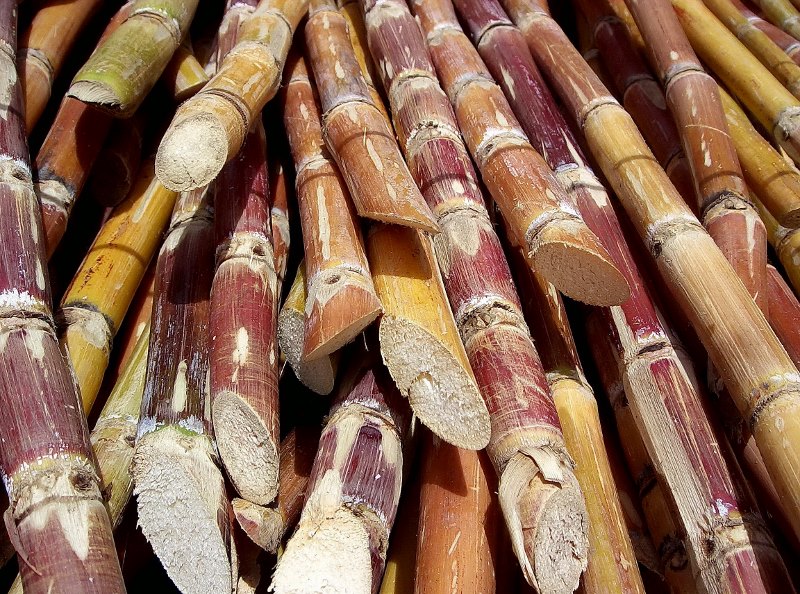
By Rufino Uribe – caña de azúcar, CC BY-SA 2.0, https://commons.wikimedia.org/w/index.php?curid=1155927
In addition to these, there is:
- Lactose, the sugar found in milk.
Glucose and fructose are monosaccarides. As is galactose. But galactose only really exists when it’s partnered with glucose, to make lactose. So I’m going to use it as an introduction to disaccharides, and then gloss over it.
Fructose, maltose and lactose are all disaccharides, which is to say they’re each made up of a combination of two of the monosaccarides. As we’ve established, lactose is made of galactose and glucose. The other two are made as follows:
- Maltose is, rather unimaginatively, made of glucose and glucose.
- Sucrose is made of glucose and fructose.
And because sucrose is the sugar that is found in sugar cane and sugar beet, it is this that we think of as ‘sugar’. The stuff you buy in the supermarkets. The stuff you add to your baking, or your coffee. Although, funnily enough, it’s not the stuff that typically goes in the fizzy drinks that got taxed. That tends to be high-fructose corn syrup. This probably started off as sucrose but goes through a process to convert some of the glucose into fructose. Which will make it sweeter…
While I’m still not sure what constitutes a good sugar, I’m very sure that high-fructose corn syrup is not it!
While we’re at it, given the number of people who are lactose intolerant, I think we can cross lactose off the list of potential good sugars. Which brings our candidates down to: glucose, fructose, maltose and sucrose.
The plot thickens…
Starting then with the most commonly available; could sucrose be a good sugar? Or, if not all of sucrose, could maybe at least one of the varieties be a good sugar. Because sucrose is available in a dizzying array of forms and varieties…
The majority of sucrose on the shelves is of the white, refined variety. By and large, this comes in three levels of crystal size, which from coarsest to finest are: granulated, caster and powdered (icing). All of which carry about 400 calories per 100 grams, or 20 calories per teaspoon.
Which is a lot!
Not that you’d expect anything as processed and refined as white sugar to be a good anything. Clearly something like Demerara Natural Unrefined Cane Sugar is going to be far better for you?
Uuuum… No!
Demerara Natural Unrefined Cane Sugar also contains about 400 calories per 100 grams; 20 calories per teaspoon. From calorific and dietary points of view, with sucrose; there is no good sugar, as shown in the table below:
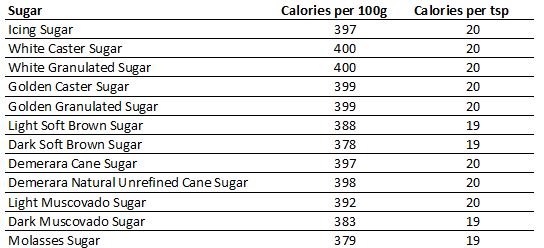
As you can see, the sugar with the lowest calorific value is Dark Soft Brown Sugar. But this still has 378 calories per 100 grams and 19 calories per teaspoon. Not such a good sugar, after all.
But still, I hear you cry, it’s not processed like that refined muck…!
Again, it’s not so clear cut as that.
All sucrose sugar seems to be processed to some extent. The cane (or beet) is harvested, cleaned, chopped and then crushed to extract the juice. The juice is chemically clarified with lime (the chemical, not the fruit), and heated to destroy enzymes. This resulting juice is then concentrated by evaporation, at which point molasses form. A great deal of the molasses are then removed, to leave brown sugar.
This brown sugar is also considered to be ‘Natural’ or ‘Raw’ sugar. The reality is that it’s been pretty thoroughly processed by this stage. Quite often, in fact, these brown sugars are actually fully refined white sugars that have had molasses added back to give them colour, flavour and texture. You should check that this is not the case when you’re buying what you think is a genuinely natural or raw sugar.
The percentage content of the molasses is what categorises the sugar product:
- Light brown sugar has about 3.5% molasses, by volume
- Dark brown sugar has about 6.5% molasses, by volume
White sugar, of course, has no molasses at all. Because it has gone through the additional stage of processing called refinement.
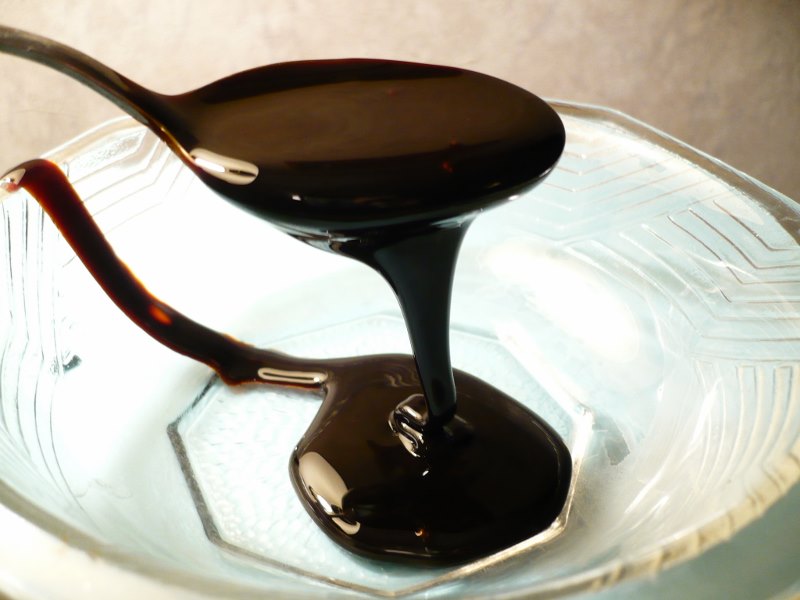
By Badagnani – Own work, CC BY 3.0, https://commons.wikimedia.org/w/index.php?curid=4129522
Refining sugar involves a carbonatation or a phosphatation process to force the sugar to form granules, which then precipitate out. After that, something like activated carbon granules are used, to remove all colour. The result being brilliant white sucrose sugar crystals. Also, perfectly pure sugar crystals, which makes them attractive for industrial processes, where quality control is an issue.
So while sucrose sugar comes in a reasonable variety, I’m not convinced that any of them are leading the charge for the title of ‘good sugar’. Additionally, there is such a thing as Sucrose Intolerance, and I think it’s safe to say that sucrose, in all of its forms, is in trouble.
Admittedly, Sucrose Intolerance is pretty rare. It’s most prevalent in the Inuit populations of North America, where it exists at a rate of 3-10%. It effects those of European decent at a rate of only 0.2 – 0.05% and everyone else at a lower rate than this. Even so, like Lactose; if there’s an intolerance, it’s not a good sugar.
And then there were three: glucose, maltose and fructose.
To start with: a comparison of the calorific values, per 100 grams:
- Sucrose: 400 calories
- Glucose: 366 calories
- Maltose: 344 calories
- Fructose: 368 calories
On the face of it, this puts maltose in a prime position, having only 86% of the calories of sucrose; a mere 17 calories per teaspoon! Which is still a huge amount of calories… but that’s because it’s sugar! It’s always going to have a huge amount of calories. There’s no such thing as a good sugar, if you’re looking solely from a calorific point of view. If calories is your only focus, then maltose is the best option. Or, more realistically; the least bad option.
Because it is so calorific, sugar has been linked to obesity. This isn’t to say that sugar specifically causes obesity, because it doesn’t. Sugar carries lots of calories and an ongoing consumption of too many calories leads to obesity. Where those excess calories come from is irrelevant to your body. If it has too many calories, your body will store that energy, as body fat, in case it needs it at a later date.
This does mean that eating too much sugar will lead to obesity, which is why many Governments offer advice and guidance on how much sugar to consume. But the sugar industry works very hard to prevent such guidelines. Or to make said guidelines difficult to understand. If you’re wondering why, let me point out that the value of the global sugar industry is projected to be $100 billion by 2022.
For example, advice about sugar consumption is often given in measurements like ‘teaspoons’ or ‘sugar cubes’ instead of grams or ounces. A teaspoon is an inherently complicated, if not deceitful, means of measurement. What is meant by ‘teaspoon’, is a level scoop of the standard 5ml teaspoon measure, used in baking and cooking. What this can be interpreted as is; a heaped scoop of whatever you use as a teaspoon at home…
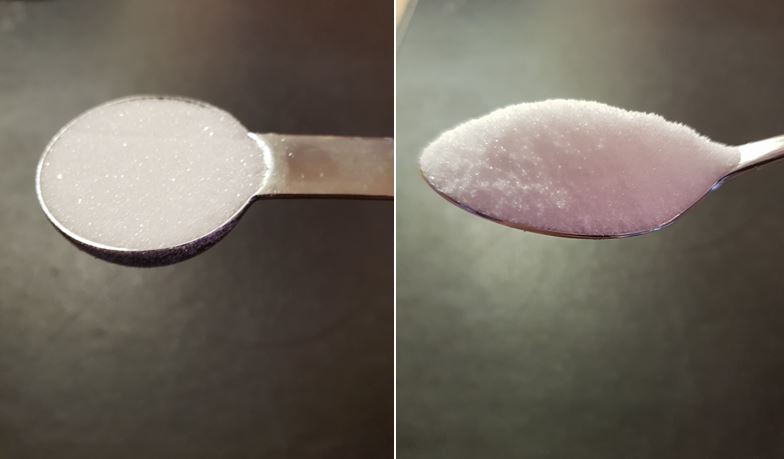
I just checked downstairs. The leveled measuring teaspoon, as expected, had 5 grams of sugar. The heaped culinary teaspoon had 7.5 grams of sugar. Which is half as much again. This means that people who are casually trying to follow the ‘teaspoon’ guidance, end up getting 50% more sugar than they think. And who does this confusion benefit? Certainly not anyone trying to watch their weight…
And who the Hell uses sugar cubes any more?!
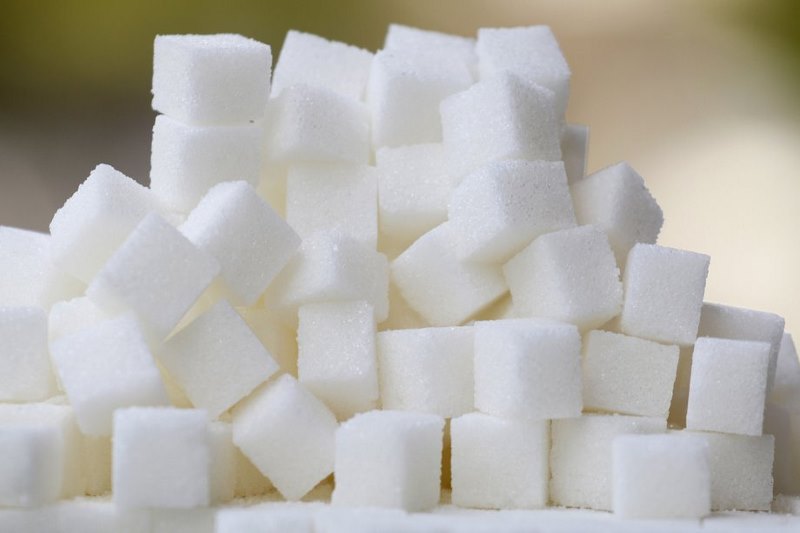
To actually see the Government advice about sugar, follow the link under the photo. It’s too detailed to get into the specifics here.
Roughly speaking, the Government advice is to limit the amount of sugar you consume from sugary foodstuffs to as low as possible. Sugary foodstuffs include confectionery, baked goods, sweetened drinks, fruit juices and smoothies.
Fruit juices might surprise some people but it makes sense when you think about it. Sugar cane is crushed to get the sugar solution out, which is then processed to isolate the sugar. But if you just drank that solution, you’d be getting a lot of sugar. Oranges, for example, are crushed to get the juice out, which you then drink without isolating the sugar. But if you did process the orange juice, you’d get 9 grams of sugar per 100 grams of juice. That’s about 20 grams for a glass of orange juice: 4 teaspoons…
Which sounds very much like an experiment I’d like to conduct over the holidays.
The problem is that generally speaking we, as humans, like sugar. There is some argument that humans have evolved to to crave high calorie foods like sugar and fat. The reasoning being that, in neolithic times, we had to fatten up for the winter and the best way to do this was to eat sugary, fatty foods to pack on the calories. Now, of course, that sugary, fatty foods are so cheap and readily available, we’re getting too much of a good thing. And obese as a result.
Lots of people say they have a ‘sweet tooth’, I’m one of these people. Some even go as far as to say that they’re ‘addicted’ to sugar. This, I remain to be convinced about. A while back a study seemed to show that rats could become addicted to sugar. Follow-up studies showed that the rats’ ‘addicted’ behaviour was due to the specific way in which the trial was set up. Meaning that there is no proof that rats get addicted to sugar. As such, there’s no proof that humans get addicted to sugar. Yet.
Speaking personally, I’m someone who loves my confectionery and baked goods. My excess weight comes from sugary foods rather than sugary drinks or alcohol. When I start a diet, which is more often than you’d believe, days two through four are spent with a headache and a foul mood. This is something that I’ve always put down to cravings for the missing sugar. But that’s it. After day four, while I miss sugary foods, I can, and do, go without. Sometimes for months at a time. Which does not seem to be a physical addiction to me…
But, none of this serves to answer whether it’s glucose, maltose or fructose that is the good sugar.
Fructose has been linked with a number of health issues, mainly because it seems to be more difficult to digest, resulting in it being more likely to be converted to fat. But it’s also for exactly this reason that fructose is the recommended sugar of choice for diabetics. So, if you’re diabetic, the good sugar, should such a thing be possible, is fructose. For everyone else; not so much.
Glucose is most easily processed by your body, because that’s what your cells need. But that also means that when you consume glucose, you get every available calorie. One other consideration is that, if you mix liquid glucose with melted chocolate, you get modelling chocolate. And with modelling chocolate you get:

Image from Choccywoccydoodah
Maltose, as well as having the fewest calories, benefits from its lack of association with fructose. And while it is 10% less calorific than other sugars, it is around 50% as sweet. Which means you would need more maltose to get your hit of sweetness, meaning you potentially get more calories overall. On the flip side maltose comes from malt and without malt you don’t have beer and whisky…
So, it’s clear then; there is no good sugar. Equally, though, there is no bad sugar, providing it’s consumed in moderation. What there can be is: too much sugar…
There is no form of sugar that can be eaten without consequences. The main of these being the calories. And the main problem with calories being that a continued excessive consumption of them leads to obesity. Just because a sugar looks unprocessed doesn’t mean there are fewer calories. And if it’s more easily digestible; that’s just another way of saying that your body can access every last calorie. Just because a sugar is in something that has been ‘freshly squeezed’, doesn’t mean that the sugars it contains can’t go straight to your hips. Or my belly.
All sugar is good sugar if it’s consumed in moderation. All sugar is bad sugar if it’s consumed in excess.
And this excess consumption is made all the more likely by the amount of sugar that is added to products you might never suspect. Heinz Ketchup, for example, is nearly 23% sugar. Heinz baked beans are 4.7% sugar. The exact same percentage as their much lauded protein content! And anything, like yogurts, that yell about how ‘fat-free’ they are; go ahead and check that sugar content…
Keeping sugar in moderation isn’t easy, because manufacturers put it in the most surprising places. But looking for sneaky sugars is a post for another time.
For now, I’ll say; a good sugar is a controlled sugar. Sugar that is within whatever daily limit you allow yourself, be it measured in grams, ounces, teaspoons or cubes. But staying within that limit requires investigation on all of our parts. Of the food and drink that we consume. Because too much sugar makes us obese, which shortens our lives…
